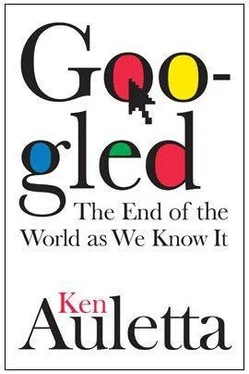Marissa Mayer claimed that half of Google’s products materialize from the 20 percent time. This has fueled innovation at Google, and has helped wreak havoc on old media companies. The engineers who come to Mayer’s office seeking encouragement and company support for their projects often start with the same assumption Page and Brin do: that the tried-and-true ways of doing things are outmoded.
Google Voice, a suite of mobile phone services, provides a good illustration of how the company’s engineers think. They began with their favorite question, Why? If we use the Internet for phone calls, they wondered, why can’t all telephones have a single number? Why do we need multiple answering machines? Why do we need to switch phone numbers when we move? Why do we need to wait to listen to phone messages? Why can’t we convert them to text messages instead? Why can’t we record phone conversations if the other party consents? Why can’t our phones block telemarketing calls or make sure certain people are screened out? Because it’s over the Internet, why can’t most calls be free?
For its beta test, in 2007, Google introduced for a relatively small group a service that would work as Google Voice does. It was called GrandCentral, the name of a start-up Google acquired a few years earlier. With their regular phones, in the initial GrandCentral pilot project, users called into a voice mail service, then pushed a button to get a dial tone. They were now on the Internet. It was free and convenient. Users liked it but Google treated it like a “maybe” product, making no commitment to expanding the service. The snickers from those who thought the Google test must have failed, as David Pogue noted in the New York Times, became sneers.
In March 2009, Google Voice was announced, and the sneers turned to gasps. Everyone in the telephone business-from telephone companies to new entrants like cable companies to eBay’s Internet phone service, Skype, which imposes small charges on calls made on regular phones-had reason to be concerned. Google would at first give away the phone service for free, with a nominal charge for long distance calls, and hoped one day to sell the service to corporations at a low price.What was an advance for consumers was a potential setback for these companies. They were being Googled.
Once again, Google’s engineers proved their brilliance. They had devised the simplest, most cost-efficient way to accomplish a task. What impact Google Voice might have on the thousands of jobs in the telephone industry or on local communities was not a question the engineers asked. Nor did they ask about privacy. Because Google would be gathering data on the calling habits of its customers, there were obvious privacy questions. Nor did they ask what the ramifications were for a society if Google Voice succeeded and became as dominant in telephony as Google is in search, online advertising, YouTube, or digitized books. These questions were beyond the pay grade of the engineers.
Many Valley companies, and others, have modeled themselves after what Chris Anderson calls “the biggest company in history built on giving things away.” In his book Free, Anderson cites the many companies that offer free services, from Twitter to Facebook to MySpace to Yahoo’s photo-sharing service, Flickr, to e-mail services to Wikipedia to craigslist to news aggregators like Digg to the free shipping and returns offered by the online shoe retailer Zappos. By offering free services, Google has reinforced the notion that traditional media now wants to combat-that digital information and content should be free. “This is the Google Generation,” writes Anderson, “and they’ve grown up online simply assuming that everything digital is free.”
Many Valley companies have now copied Google’s 20 percent time, including the one Bill Campbell chairs, Intuit. Facebook offers subsidized housing for employees who live within a mile of the office, free meals, parking, gym memberships, laundry services, and a host of other benefits that mirror Google’s. “Google has raised the bar for everybody in the Valley,” said Campbell. “Everyone has to respond to the pressure that said, ‘If the engineer is good, we better hire him before Google does.”’
Of course, Google has borrowed as well as led. Stanford president and Google director John Hennessy, who once chaired his university’s computer science department, believes some Google ideas-such as the 20 percent time-can be traced to Stanford “and the academic world,” where Stanford graduate students like Jerry Yang and David Filo on their own time in the computer lab concocted the idea for Yahoo. Page and Brin have acknowledged that they took cues from the generous way Genentech treated its medical scientists, including a 401 (k) plan that matched up to 5 percent of their salaries; this was one of the reasons they recruited its CEO, Art Levinson, to join Google’s board. Google has a pet dog policy-allowing dogs to accompany owners to campus, providing an outdoor space, offering veterinary services-that Larry Page said was copied from Netscape.
Nor is Google unique. Netflix drives its employees hard but among other generous benefits, it lavishes unlimited vacation time on them. The e-commerce site Zappos encourages employees to point out any other employee who does outstanding work; that person then gets a fifty-dollar bonus from the company. Zappos also employs a full-time “life coach” who lets employees vent and serves as a corporate shrink.
Google has done something else that sets the best companies apart: it earned its customers’ trust. Google regularly ranks among the world’s most respected corporate brands. All companies endlessly talk about achieving brand status, but few attain it. They fail because they often confuse brand with name recognition; they don’t recognize that brand is a synonym for trust, which is not something that can be purchased with a rich marketing budget. Most consumers trust the information in the New York Times, the Think Differentness of Apple, the taste of Coca Cola, the safety of a Volvo, the bargain prices at Wal-Mart or Southwest Airlines. If we think of the Internet as a copying machine that produces free information, as one of the founders of Wired magazine, Kevin Kelly, wrote on his blog, then “how does one make money selling free copies?” Kelly’s answer: “When copies are free, you need to sell things which cannot be copied.” The first of these, he said, was “trust,” which is not duplicable. “Trust must be earned, over time.”
That trust is founded, in part, on a feeling that a company both serves noble ends and yields wealth for its shareholders. Recall the “Letter from the Founders” that was part of Google’s 2004 IPO, in which Page and Brin declared, “Google is not a conventional company. We do not intend to become one.” They said they would focus on users, not investors, and that they’d be concerned not with “quarterly market expectations” or paying dividends but rather with protecting Google’s “core values.” In a Q amp;A published as part of Google’s prospectus, Brin said the company’s aim was “greater than simply growing itself as large as it can be. I believe large, successful corporations… have an obligation to apply some of those resources to at least try to solve or ameloriate a number of the world’s problems and ultimately to make the world a better place.” They would try to serve, as Eric Schmidt said, as “a moral force.” The combination of free services, coupled with principled stances like its refusal to allow advertisers to rent space on its home page, or its insistence on a customer service that communicates to users that Google wants to get them to their destination quickly and without trapping them, have helped convince consumers that these goals were genuine. When the tsunami struck Southeast Asia in December 2004, Google made a billboard on its home page to alert searchers to the various international relief efforts they might assist. In 2008, Google Flu Trends began tapping the company’s database to predict flu incidents well ahead of the health warnings issued by the Centers for Disease Control. “Who would have thought,” said Steven Rattner, then managing partner of the venture capital firm Quadrangle, “that a bunch of computer geeks would turn out to be the best marketers of the twenty-first century?” Little wonder, then, that Google in 2009, as in prior years, was again ranked by Fortune as one of the “World’s 50 Most Admired Companies.”
Читать дальше










